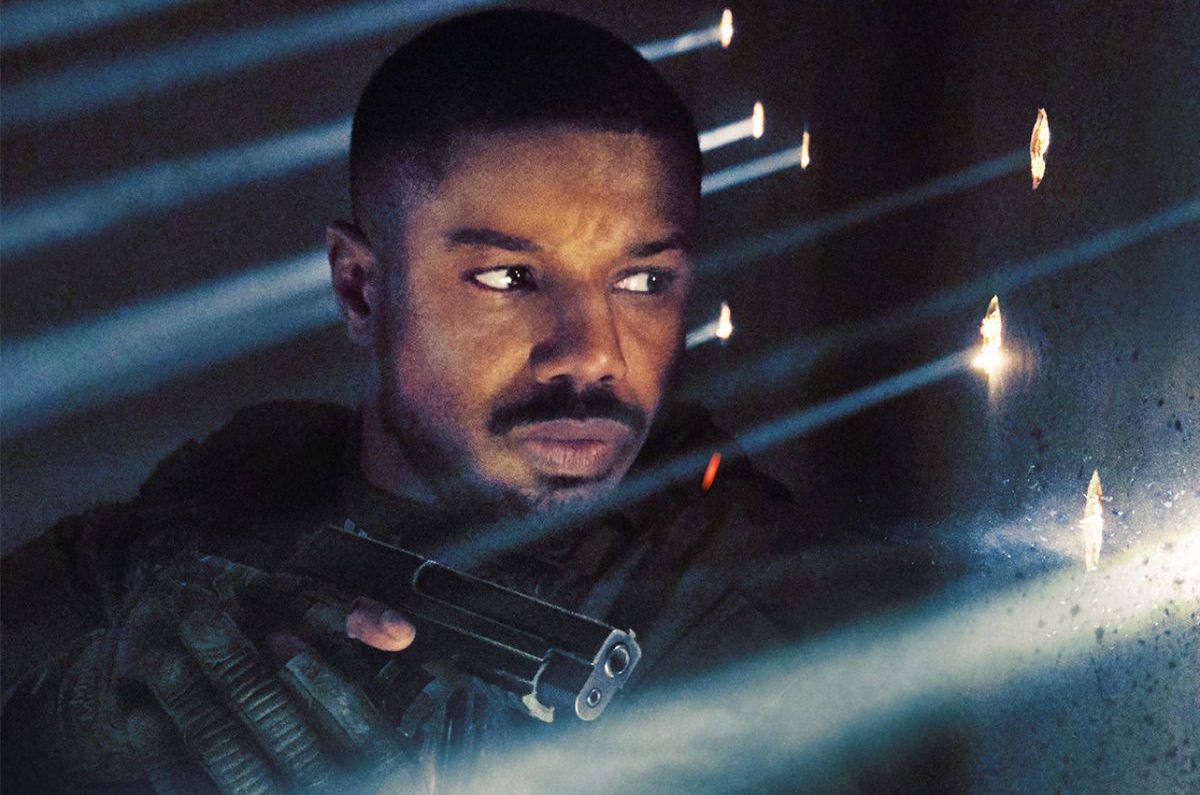This article contains Tom Clancy’s Without Remorse spoilers. You can find our spoiler-free review here.
For the most faithful Tom Clancy fans, it’s probably not the ending they anticipated. Amazon’s adaptation of the author’s John Clark origin story, Without Remorse, ends not with a justification for Cold War paranoia but instead with a greater fear of the enemy within. Defense Secretary Thomas Clay (Guy Pearce) swore to uphold the Constitution and American interests. But in the end, the only oath kept was the one Michael B. Jordan’s then-John Kelly made to his late wife Pam.
“Her name was Pam, and [I swore] you’re going to say it before you die.” And so Clay did in his final moments after John drove the secretary’s vehicle off a D.C. bridge and into the cold waters below, drowning the old man and making it look like a suicide.
It’s a relatively downbeat climax to a movie that’s featured high octane shootouts, fisticuffs, and one gnarly torture sequence in a burning car. Yet it’s worth considering how the movie got to this watery moment, and how it appears to be intentionally tweaking Clancy’s worldview.
Throughout much of Without Remorse, viewers think they’re watching a simple revenge movie. At the top of the film, John led his team of Navy SEALs on a mission to Syria on the pretext that they were rooting out Syrian sanctioned murderers and thugs. Who they really left dead, however, were Russian spies. Afterward, every member of Kelly’s team was murdered seemingly by Russian agents, as was John’s wife and unborn daughter, who were executed while Pam slept.
Following the assault on his wife, Kelly went into Jack Bauer mode and killed every Russian official and underling who could bring him closer to Viktor Rykov (Brett Gelman), the alleged Russian operative who led the attack on John’s home at the beginning of the movie. And to be sure, Rykov was certainly there, as both John and the audience saw him with his mask off when John was shot during the home invasion.
However, the big twist of Without Remorse is that Rykov was not a Russian asset; he was an American one. When John, Naval officer Karen Greer (Jodie Turner-Smith), and CIA agent Robert Ritter (Jamie Bell) track Rykov to a Russian apartment, they discover the whole movie has been an elaborate ruse, played at the expense of American intelligence and (soon) the public. John and his family were just collateral damage.
“There are no other ops, John,” Rykov says when the American special forces team corners him in an apartment, revealing he’s been lying in wait with a suicide vest. “You and me being here is the real op.”
As Rykov explains before pushing the button, he fancies himself a true patriot, even more so than “those behind us in Washington.” He’s been convinced that the best way he can serve his country is by dying in a fiery explosion in Russia. His goal isn’t to take John Kelly or his team with him either. It’s quite the opposite, in fact. Rykov is working for “those behind us,” and those D.C. insiders needed John, or an American soldier like him, to be in the building when the explosion went off. That way it’d look pretty damning to Russian authorities, especially since snipers working with Rykov murdered the first Russian cops to arrive at the scene.
This plan was executed on the assumption that an international incident would be created when it reached the press that American soldiers were killed on Russian soil while performing an illegal operation—which itself would be seen by the American public as retaliation for the illegal operation on American soil that killed John’s wife.
That perception is why Rykov personally executed the man who actually shot Pam in her bed. Rykov didn’t know John would take more of their men down, but the trigger man handed Rykov his gun, ready to die because it would build the narrative that Russian agents murdered an American family in their own home. If Americans then died in an even bigger clusterf*ck in Russia, the ensuing chaos would usher in a new Cold War. Hence rather than Russians being the bad guys, the villains of Without Remorse are Americans who want to pretend the 1980s never ended.
John, Ritter, and Greer figure out this much when they let John go ghost and report back to Langley he died in the explosion. John “being dead” gives him the freedom to sneak up on the Defense Secretary and test whether he actually had knowledge about Rykov’s op. The fact the Cabinet member didn’t balk when John mentions the suicide vest—a detail Greer intentionally left out of her report—is all he needs to know. Soon enough, with threats against his family, Clay plays ball and spills his guts about the whole setup.
“You know who won World War II?” Clay whines. “It wasn’t the generals or the admirals, it was the economists. War, tanks, planes, and all that spending lifted this entire nation out of poverty, freed the world from tyranny. A big country needs big enemies. The best enemy we ever had was the Soviet Union. Our fear of them unified our people, gave us purpose. The problem today, John, is half this country thinks the other half’s its enemy because they have no one else to fight.”
In other words, the shadowy conspiracy (which is still not fully unmasked) involved high ranking officials in the executive branch engineering a phantom menace out of Russia by killing a few Americans and a few Russians in both hemispheres. They only failed to anticipate how hard John Kelly would be to kill. Yeah, that’s definitely worth a dip in the drink.
What’s interesting is that this ending pretty much flies in the face of Clancy’s literary Without Remorse and his generally Cold War-attuned worldview. On the surface, this could be viewed as a naked attempt to play into the worst cynicisms of our age. While the movie was filmed before the Covid pandemic and 2020 election, it very much was written and produced after the 2016 one where Russian intelligence mounted a disinformation campaign designed to sew division in the U.S.
When a newscaster says in Without Remorse that this is the lowest moment in relations between the U.S. and Russia since the Cold War, a viewer doesn’t have to imagine what that plot point feels like. Some might therefore read Without Remorse’s ending as a subtle play on the conspiracy theories in the U.S. (some of which were propagated by a former American president) that suggest any reports of Russian election interference are exaggerated.
However, I would disagree with that reading of the Without Remorse ending. While the film certainly plays fast and loose with “ripped from the headlines” plotting, the film feels as much a subtle critique of Clancy as any sort of movie about modern realpolitik.
It is indeed worth noting how much the cinematic version of Without Remorse differs from its source material novel. As with all Clancy page-turners, the narrative of Without Remorse is arguably too dense to transfer to a two-hour film. So gone are entire subplots involving prostitution rings and the historic crime of funneling Asian drugs to the U.S. inside the corpses of dead American soldiers (the book is set in 1970 during the Vietnam War). But also gone is the fact that the bad guys really are the Russians.
On the page, the man Kelly killx turns out not to be a KGB mole, but there is indeed a Russian asset high up in the U.S. government: he’s a senator’s aide who is cooperating in Russian efforts to sabotage the Vietnam War effort. And by working for an anti-war dove politician, one can sense the disdain in Clancy’s politics, which imagines anti-war leaders at least playing into Russian interests to undermine American foreign policy. (Oh, what he might’ve thought about his political party in 2020?)
In Clancy’s novels, the villains are almost always the Russians or other foreign threats attempting to besiege Fortress America. For all their technical authenticity and understanding of late 20th century spycraft, they’re very much fantasies tailor-made for the era Clancy found his initial success in as an author: Ronald Reagan’s 1980s America. In fact, what turned his first bestseller into a bestseller was President Reagan enthusing how satisfying the plot is in The Hunt for Red October.
Read more
This is not to say that Clancy’s worldview was as simplistic or jingoistic as his critics might suggest. After all, that first novel which birthed the best Clancy adaptation to date, John McTiernan’s The Hunt for Red October (1990), is about a Soviet submarine captain attempting to de-escalate the Cold War by defecting and funneling a nuclear Russian sub to the Americans. Of course, this is also because he and most of his officers secretly covet the freedoms borne from the democratic and capitalist West.
Other Clancy novels are not quite so nuanced in their view on Cold War politics, including literary Without Remorse. Yet the movie version of the film ironically brings it closer to the first novel, as well as another book/film which introduced fans to John Clark on screen: Clear and Present Danger.
That tangled narrative involves the perceived menace of South American narcotics at the height of America’s drug war and the criminal empire of Pablo Escobar. However, the greatest villain in the story, particularly the movie adaptation released in 1994, turns out not to be drug lords but a corrupt president who uses the War on Drugs as an excuse to turn American special forces into a personal hit squad out for his revenge—he then leaves those soldiers stranded to die.
The ending to Michael B. Jordan’s Without Remorse very much comes in line with the wary cynicism of Clear and Present Danger, which also feels a lot timelier after the last four years than it did in the ‘90s.
In fact, 2021’s Without Remorse leads fairly well into the Clear and Present Danger movie. At the end of Without Remorse, John Kelly drowns the Defense Secretary, making it look like a suicide. He is then saved by Karen Greer, who must’ve known about John’s plans to drive off the bridge. Remember, she helped set Clay up by omitting Rykov’s suicide vest.
She then escorts John to the airport and gives him his new CIA sanctioned identity, John Clark. Clark is of course the more famous name of Clancy’s protagonist. He is also introduced by that alias in Clear and Present Danger when Robert Ritter, now Deputy Director of the CIA, travels down to Panama City to meet Clark and enlist him in the corrupt POTUS’ secret war against Colombian cartels.
Barring the differences of actors and eras, one could even watch 1994’s Clear and Present Danger movie (also on Amazon Prime) and see a pseudo-sequel to Without Remorse. In the ‘90s movie, Willem Dafoe plays Clark as a hardened and skeptical expatriate who’s been living in South America for some time. He and Ritter have a long off-screen history, with the CIA bureaucrat eventually persuading Clark via the government’s checkbook to lead an illegal special ops team, which has eerie parallels to the Reagan administration’s own South American misadventures with the Iran-Contra Affair. In the ’94 film, Ritter is a slimy middle man for the corrupt interests of the White House, and it is not hard to imagine Jamie Bell’s 21st century Ritter from Without Remorse going along with a similarly corrupt fiasco.
Of course Clark is still a hero in the earlier movie, eventually teaming up with Harrison Ford as CIA analyst Jack Ryan. They even build trust over a mutual friendship with Rear Admiral James Greer, who is mentioned as Karen Greer’s off-screen uncle in the Without Remorse movie.So in the end, it’s all connected. Or perhaps this can just become the sequel crossover with Amazon’s Jack Ryan TV series?


